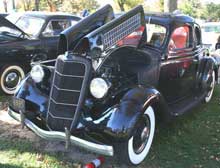Meeting Standards
A few months ago, I said I remember "Mommycar," my mother's 1935 Ford, as a Standard model. I'm beginning to doubt my recollections, as Standards came with one taillight and the only photo I can find clearly shows two. Of course, some items standard on the Deluxe model, like the second taillight and second horn, could be ordered as options or fitted by a dealer. We don't have a frontal view, so we can't tell if the car had the chrome grille and windshield moulding of the Deluxe or painted style of the Standard.
Ford's model distinctions in the mid-1930s were subtle. In 1934, the Deluxe customer got a better interior, additional brightwork, a second horn and taillight, cowl lamps and body color fenders. The differences were similar in 1935, bright versus black and two taillights in place of one. This held true in 1936 as well, but the horns were now hidden behind round fender grilles, obscuring an identity clue. Standard cars were available only in closed body styles.
For 1937, too, painted versus bright grilles and windshield mouldings were the only tell-tales from the front, though the new small V8-60 engine was available in the Standard model. The following year, however, Ford made it plain what Deluxe customers got for their money - an attractive new nose with heart-shaped grille. Buyers of the Standard received a warmed-over 1937 nose, though the effect, if old, was not unattractive. In turn, the 1939 Standard Ford was based on the '38 Deluxe, while the new Deluxe had entirely new front sheet metal.
Sealed beam headlights were the new feature for 1940, and both series had them. The Deluxe accented them with bold chrome rims and a new grille, while the Standard was given to body color trim and a variation on the '39 Deluxe grille. This was the final year for the V8-60.
For 1941, new bodies and chassis put an end to separate sheet metal for the series, of which there were now three. What had been Deluxe was now Super Deluxe, with appropriate brightwork, while Standard became Deluxe, with painted side grilles and windshield mouldings. A six-cylinder engine supplanted the small V8, and there was an economy Special series offered in three body styles in one color choice (Harbor Gray) and the six-cylinder engine. A similar lineup was offered for the abbreviated 1942 model year.
After the war, there were two series, of varying names, until 1952 when upscale models were put into a new Crestline series. Never again, however, did Ford offer different different sheet metal for different series until the compact Falcon of 1960.

